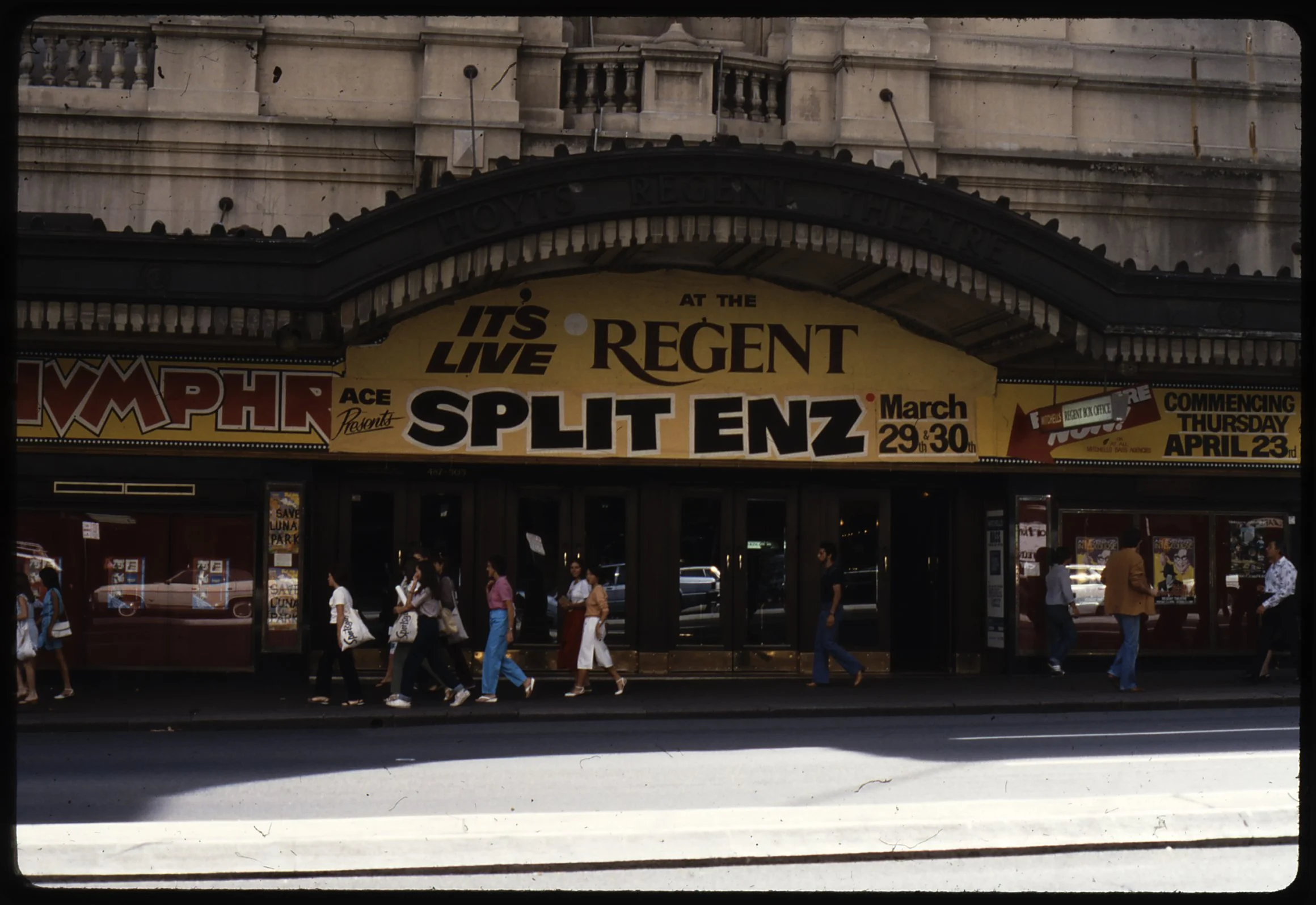Colour-music Split Enz
Stage Lighting, Set Designer, Lighting Director/Operator for Split Enz 1975-1983
Raewyn Turner
From 1975 to 1983, I toured with Split Enz extensively in Australia, New Zealand, Britain, Europe, the USA and Canada. I was awarded Gold, Silver, and Platinum albums by A&M Records
1975-1983: I worked in collaboration with Split Enz as their lighting and set designer, I travelled in trucks and buses with road crews across USA, Canada, Europe, and Australia. I was a fellow student at Elam school of Fine Arts with Noel Crombie, Phil Judd and Robert Gillies.
My intention was to use the contemporary music medium and popular culture to make a change in the way in which it was experienced, and secondly to address the way in which the culture of youth protest is packaged and sold back to youth. Split Enz fully supported my experimentation and the music industry had funds for equipment and lighting technology. 1975 was at a time when as a young woman I had the opportunity to work with coloured light to express my coloured equivalents to music—Colour Music— and to work in an area where women were absent, The early seventies were a time of transformation. Along with The Equal Pay Act 1972 which extended equal pay to women in the private sector and Germaine Greer’s The Female Eunuch (1970) an important text in the feminist movement, those years were a time of emancipation and liberating women from traditional constraints.
I translated their music into the deepest saturated colour, employing after-images, coloured shadows, hand painted optical pattern projections, stop motion, UV, the darkness, monotones, optical illusions, contrast and emotional colour sequences. Throughout my endeavours were tied to my coloured music equivalents which I experienced with music.
I regarded my work as art and it was often referred to as an integral part of the performances, the reviews referring to ‘explosions of colour’, ‘like painting with light’. The symbiotic nature of it meant that my work could only exist in the performances or in the various video clips that we made for broadcast.
Later, in 1997 my interest in using light was rekindled when I learnt that the sun rings like a bell, inspiring me to make work again with sound and light connections, starting with ENZSO in a series of performances of Split Enz with the New Zealand Symphony Orchestra.
1997 ENZSO, Designed and Directed Lumia Australia. Adelaide Symphony Orchestra,Youth Choir,Eddie Rayner,Split Enz
1996 ENZSO, Designed and Directed Lumia New Zealand Symphony Orchestra, Youth Choir, Eddie Rayner, Split Enz, Poet Sam Hunt.
Documentary Split Enz - Spellbound (1993) The career of New Zealand's pop band Split Enz is recounted from their formation by Mike Chunn, Phil Judd and Tim Finn at Auckland University in 1971 to their demise in 1984, when Neil Finn walked away.
Directors
A large collection of Documentaries and Podcasts on Split Enz collated by DigitalNZ Split Enz by NZ on Screen
Raewyn Turner Frenzy Album Cover Painting
Frenzy album cover painting
I became interested in performance art in 1972 while at Elam school of Fine Arts. My first performance was on stage with the original Split Enz band who were then called the Mellodrone. I sat facing the audience, knitting and watching the audience.
I finished my honours year and then joined Noel Crombie in 1975. Noel and ‘Split Ends’ had been working in Australia for 8 months. When they needed someone to switch the lights off and on for their performances in the long low drinking barns I volunteered. I realized that I could match the colours that I experienced with music, with coloured light! So this became my new palette, a palette of colour equivalents —experimental art.
It was a parallel collaboration, the band never told me what to do as I never told them what to do. I wanted the audiences to be empowered by being immersed in very loud sound and very saturated colour; experiencing music in a different way could traverse the boundaries of music for ears only, to synchronous music for eyes, which has the effect ( now commonplace due to digital technology) of striking a resonance in the body.
Light is reflected from objects so I played with that and the additive palette of red, green and blue. After a few months working with the band in Australia we travelled to London.
In London I met up with Larry Learmonth and his wife Mandy who invited me to work alongside them in their studio on the top floor of their house in Radlett, Hertsforshire. I was putting together a portfolio to enable me to apply for illustration work and Larry encouraged me to paint an album cover for the band.
I was curious about different mental states. I’d had a severe car accident 18 months before I attended art school and consequently a near-death experience, and several friends had suffered electric shock treatment. I was also interested in Richard Dadd’s paintings which he’d created at Bethlem aka Bedlam a London mental health hospital in London. I arranged for the band to visit a disused mental asylum near Radlett so I could photograph them against some of the empty weathered buildings on the compound. Then I placed them against a utilitarian rusted corrugated iron farm shed, iconic of the NZ landscape especially in rural Hawkes Bay where I grew up. Besides, I’ve always loved farm animals, farms and their old buildings which indicated some human history of activity; Apart from those the NZ landscape always seemed to me that it reflected a feeling of isolation and emptiness. At that time it was said that the sheep were more plentiful than the humans in NZ, a ratio of 5 to 1. I turned the sheep around facing their backsides to the viewer.
Meeting Bette Midler. Bette did a thumbs up to me and said ‘girl power!’




